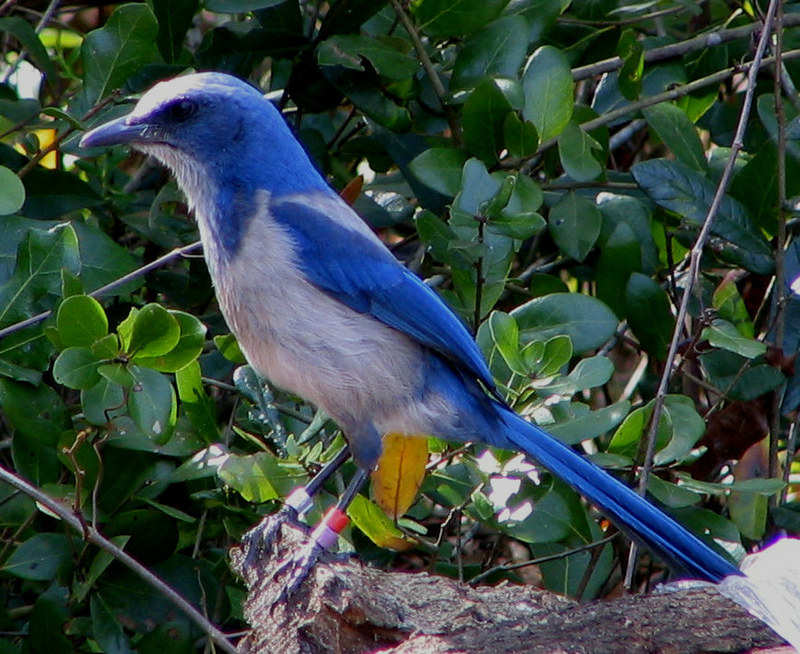Florida Scrub-jay (Aphelocoma coerulescens) - wiki Florida Scrub Jay
From Wikipedia, the free encyclopedia
[Photo] Florida Scrub Jay, Blue Springs State Park, Orange City, Florida. Taken by User:Mwanner http://en.wikipedia.org/wiki/User:Mwanner Date: 28 Feb, 2006.
The Florida Scrub Jay (Aphelocoma coerulescens) is one of the species of scrub jay native to North America. It has little fear of humans. It is the only species of bird endemic to the U.S. state of Florida. Because of this, it is heavily sought by birders who travel from across the country to observe this unique species. It is known to have been present in Florida as a recognizably distinct species since at least 2 mya (Emslie, 1996); possibly it is derived from the ancestors of Woodhouse's Scrub Jay, the inland forms of the Western Scrub Jay (Rice et al. 2003).
It is 28 cm (11 inches) long, and weighs 75-85 g (2.5 to 3 ounces). It has a strong black bill, blue head and nape without a crest, a whitish forehead and supercilium, blue bib, blue wings, grayish underparts, gray back, long blue tail, black legs and feet.
Ecology
The Florida scrub-jay found only in Florida Scrub habitat, an ecosystem found only in central Florida. It is characterized by nutrient-poor soil, occasional drought and frequent wildfires. Because of this somewhat harsh weather pattern, it is host to a small assortment of very specific plants, including sand pines, sand live oak, myrtle oak, Chapman's oak, scrub oak, and various other hardy plants such as cacti.
An inquisitive and intelligent species, the most striking attribute of the Florida Scrub Jay's behavior is its remarkable tameness. Scrub Jays show almost no fear of people and will even take peanuts from people's hands and lips. Scrub Jays will also steal silverware and other shiny objects in a manner similar to the American Crow.
Florida Scrub Jays are omnivorous, and eat a wide variety of acorns, seeds, peanuts, insects, tree frogs, turtles, snakes, lizards, bird eggs, nestlings, and young mice. They routinely cache thousands of acorns a year, burying them just beneath the surface of the sand. They are typically buried in the fall and consumed during the winter and spring. Those acorns not found germinate, making the Florida Scrub Jay a premier disperser for a variety of oak trees.
Relatively quiet for a jay, the Florida Scrub Jay is usually seen before it is heard. Calls vary, but a throaty quay, quay, quay is common. Females make a distinctive "hiccup" call.
Reproduction
Florida Scrub Jays are also one of the few cooperative breeding birds in North America. Fledgling Florida Scrub Jays remain in their parent's habitat for several years and help to rear young, watch for predators, and defend territory against neighboring Florida Scrub Jay family groups. These families can range in size from 2 to 8.
After about 2 to 3 years, fledglings leave the group to form mating pairs of their own. Mating season ranges from March to June. Clutches usually contain about 3 to 4 eggs which are incubated in about 18 days. Fledging occurs in about 16 to 19 days.
Conservation
Scrub habitat has dwindled considerably in the past several decades as Florida has continued to develop. Fire suppression also leads to the natural succession of large oaks and trees which changes the habitat. In recent years, environmental groups within the state have made a strong effort at preserving Florida's remaining scrub through controlled burns and even clearing out areas of large trees to increase the size of a scrub habitat.
The Florida Scrub Jay was officially listed as a threatened state species by Florida Game and Fresh Water Fish Commission in 1975 and it was listed as a threatened federal species by the U.S. Fish and Wildlife Service in 1987.
In 1993, there were estimated to be 4,000 breeding pairs left in the wild. Despite the protections, the Scrub Jay is still thought to be on the decline. Studies done in Brevard County, once the most numerous Florida county for Scrub Jays, noted declines of about 33% since the 1993 census alone.
Another attempt to conserve the bird is an ongoing campaign to name the Florida Scrub Jay the new state bird of Florida. Another argument for changing the state bird is that the current bird (viz. the Northern mockingbird) is the state bird of several other states while the scrub jay is exclusive to Florida.
In recent years there has been some debate about whether or not the Florida Scrub Jay should be officially listed as an Endangered Species. However, environmentalists hope that current conservation efforts should help the species population to at least stabilize.
On the other hand, the IUCN classifies this species as vulnerable to extinction VU B1ab(i,ii,iii,iv,v); C1+2a(i) (BirdLife International 2004). This signifies that in 2004, the population was declining and no more than 10 subpopulations were known. Both the number of adult birds as well as amount and quality of habitat were in decline, and local subpopulations were in danger of disappearing altogether. About 8000 mature birds were believed to exist - with no more than 1000 in any one subpopulation -, and population numbers had dropped by about 10% over the last decade or so.
A long-term and ongoing study of the Florida Scrub Jay has been taking place at the Archbold Biological Station at Lake Placid.
Etymology
Aphelocoma, from Latinized Ancient Greek aphelo-, "soft" (Ancient Greek: apalos, απαλ????) + Latin coma "hair", in reference to the smooth plumage of birds of this genus compared to other corvids. coerulescens, Latin for "becoming blue", in reference to the species' color which is lighter than in most American jays.
http://en.wikipedia.org/wiki/Florida_Scrub_Jay
| The text in this page is based on the copyrighted Wikipedia article shown in above URL. It is used under the GNU Free Documentation License. You may redistribute it, verbatim or modified, providing that you comply with the terms of the GFDL. |
